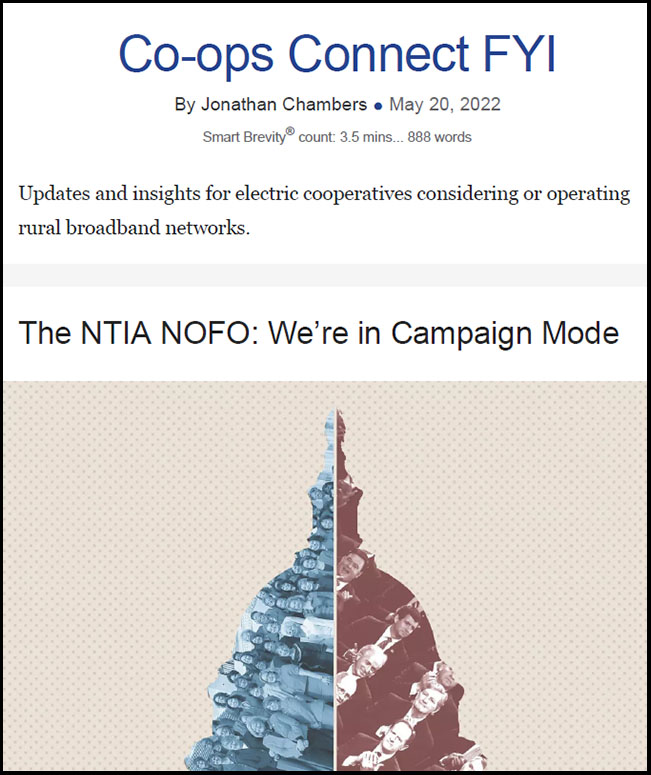The NTIA NOFO: We’re in Campaign Mode
May 20, 2022
According to Axios, President Biden has been instructing his aides to shift into campaign mode:
“He wants to make November's congressional and gubernatorial contests into choices between two competing visions, rather than a referendum on his two years in office.”
That’s the prism through which you can view the NTIA’s release last week of the Notice of Funding Opportunity (NOFO) for broadband infrastructure. It is more of a political document than a broadband plan.
What they're saying:
Immediately upon the release of the NOFO, Washington lobbyists gushed.
“A historic day for FBA, ” according to the Fiber Broadband Association (FBA).
“A tsunami of funding,” promoted another.
If you want a less frothy, more seasoned perspective, follow Doug Dawson’s Pots and Pans blog. I recommend his full blog post on the topic, but I’ll quote a few of his comments here:
“These are going to be the most complicated broadband grants ever.”
“The grants add a lot of cost to the projects.”
“The grants are clearly stacked against new ISPs.”
“This is going to overwhelm state broadband offices.”
The big picture: Doug’s observations are, as usual, clear-eyed about the road ahead.
The Basics of the NOFO
Go deeper:
Doug points to novel requirements of the program:
1. A cybersecurity plan
2. A climate resiliency plan
3. A supply chain risk management plan
4. A middle-class affordability plan
5. A project workforce continuity plan for those not using union labor
But that’s not all. Some of the additional costs imposed by NTIA include:
1. Environmental and historical preservation survey
2. Prevailing wage requirements
3. Bank letters of credit
4. Participation in workforce training and apprenticeship programs
5. New and more restrictive Buy America requirements
What's next:
Over the coming weeks and months, I’ll unpack the NOFO.
I should say, “weeks, months, and years” because if you are going to be dependent on public funding for broadband in an unserved rural area, pull up a chair. It’s going to be a while.
Patience, Not Exuberance, is a Better Watchword
What do I mean by a political document?
The NOFO is so filled with provisions extraneous to constructing and operating broadband networks that you might think that NTIA is unserious about rural broadband.
Make no mistake. This is a serious document, a serious statement about campaign politics.Whether you agree or disagree with any of the specific policies, the program regulations will drive up cost of building fiber networks in rural areas.
And not by a small amount.
- Inflation has already driven up the cost this year.
- The NTIA requirements will likely increase the cost by 25-50 percent.
The bottom line:
In some places, a project that needed public funding may no longer be feasible even with public funding.
Go deeper:
One could make a valid case about the importance of environmental review of the sort required here and in the ReConnect program.
- The most environmentally sound approach to building broadband networks is to put fiber on existing electric infrastructure.
- Yes, but: Environmental reviews under the ReConnect program have stalled and killed electric co-op fiber projects.
One could be fully supportive of Buy America provisions as important to the U.S. manufacturing base.
- Many of our projects use RUS loans, which require compliance with traditional Buy America provisions.
- Our construction projects require over 1,000 miles a week of steel strand, fiber cable, connectivity equipment, and other materials.
- In my conversations with materials vendors, none of them think they can comply with the new Buy America provisions and willneed to seek waivers.
- You might expect that waivers will be forthcoming, but that creates uncertainty and raises the prospect that the supply chain for broadband networks will be further disrupted.
One might expect pro-union provisions from a pro-union President.
- But over half the states on the country have passed right-to-work laws.
- Prevailing wage provisions and other labor provisions in the NOFO are more political than practical.
Further Dividing the Country
I recall a conversation I had about rural broadband with a senior White House official. This person knows that I’m a Republican, and said:
“We’re Democrats. They [rural Americans] are not our people.”
Who then, is the Biden Administration playing to when it comes to rural broadband? That is what the NOFO makes clear.
1. Labor
2. Environmentalists
3. The middle class
Why it matters:
Remember, states are the applicants for the $42.45 billion BEAD program.
- States are the ones that must prepare a broadband plan that comports with the NTIA NOFO.
- State procurement laws, state right-to-work laws, and state broadband laws will conflict with the NOFO.
The bottom line:
State broadband offices will be put in the middle of an argument between the Biden Administration and Republican governors.
The Big Picture
My point is simply this:
Since 2010, the federal government has spent nearly $100 billion on rural broadband, and the effort has been an abject failure.
- Congress has now appropriated another $42.45 billion for states to implement rural broadband.
- It is not tautological that rural broadband should be the primary goal.
- The social good of the secondary objectives of various policies is debatable.
- But those secondary objectives should not interfere with the goal of delivering broadband to those long in need.
Let the states do their job without turning rural broadband into yet another political food fight.
